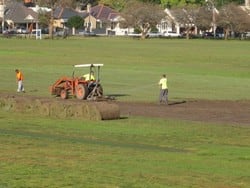Centennial Parklands receives over 31 million visits per year.
In 2007-08, the Parklands hosted over 17,000 participants on recreational, educational and cultural events and activities, and took around 700 individual sport and recreation bookings, attracting in the order of 730,000 participants per year (including all Trust-run and third party-run programs, Moore Park Golf, Centennial Parklands Equestrian Centre).
As such, these Parklands are some of the most intensively used grounds in Australia. With this level of demand and activity for our sports fields, there is a need for the Trust to balance the needs of the social/recreational needs of the community and environmental needs of the physical environment.
Due to a range of factors (including inclement weather, carrying capacity, and time required to conduct routine and seasonal maintenance), the Trust periodically needs to close some sports fields – leading to temporary displacement of sports hirers and regular users.
Public safety
Like any public landowner, the Trust is required to maintain it’s assets in a safe and responsible manner. Public safety is critical to the provision of sports fields, and is dependent on maintaining turf in robust health over a smooth and even ground plane.
It should also be recognised that community expectations regarding the standard and safety of sports fields has been increasing, and many public landowners, like the Trust, must take an approach to sports field management that allows it to meet these rising expectations.
Environmental protection
 Turf ‘recovery’ between seasons from the impact of intensive use is another serious issue. Without seasonal renovations to improve drainage, to reduce rootzone compaction, to aerate the soil and to allow the grasses to grow back, sports fields would rapidly become bare and unplayable.
Turf ‘recovery’ between seasons from the impact of intensive use is another serious issue. Without seasonal renovations to improve drainage, to reduce rootzone compaction, to aerate the soil and to allow the grasses to grow back, sports fields would rapidly become bare and unplayable.
Due to the demand for sporting fields in Centennial Parklands, the Trust is not able to schedule a lengthy recovery period between the summer and winter (and vice versa) sports seasons.
A mutual obligation
The Trust views the provision of public sports fields as a mutual obligation between provider (Trust) and user (public). While the Trust works hard to prepare and maintain safe and reliable surfaces, the public should treat these fields in a manner that respects their condition and assists in the ongoing viability of the turf to maintain the fields in a safe playable condition.
Closure criteria
The criteria behind the closure of sports fields are based on visual inspections where we look at the following factors:
- how much water is present on the turf surface;
- how wet is the turf surface and can it stand up to the rigours of sporting activities without the quality of the surface being affected;
- the location of the field and the soil type present (eg. Queens Park drains far more freely than Moore Park West where there are constant drainage problems);
- the provision of a safe facility for our users; and/or
- ensuring that fields are available for use as quickly as possible and not have to be closed for extended periods to due a loss of quality of the turf surface through allowing sporting activities after during wet periods.
Programs for improvement
To assist in improving our sports fields’ performance, the Trust has a long term program to progressively upgrade the drainage of the fields, however with 35 sports fields across the Parklands, this is a high cost exercise.
Funding challenges
The Trust also uses its fees and charges process to assist in managing and improving its facilities. Sports fields have hire fees set annually to allow broad community access and use, and to assist in the cost of maintenance and improvement.
Fees and charges are not the entire solution, however, as to raise these charges to fund the majority or entire cost of maintenance would be wholly unacceptable to the community.